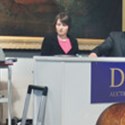The venue might have been a former egg sorting shed on the outskirts of town, but in the end they made an international price.
The result, well above the "in excess of £1m" estimate, produced a round of spontaneous polite applause from the watching crowd of 150 or so locals.
The price is the highest for any painting sold at a UK regional auction house. However, it did fall short of the £2.6m paid for a Yuan vase at Woolley and Wallis in July 2005, which remains the most expensive lot ever sold in the provinces.
No major figures from the London trade or the museum world were present in the room, leaving auctioneer Guy Schwinge to field a three-minute flurry of bids from four telephones.
Duke's Matthew Denney was speaking to the successful buyer - described as an anonymous European - who saw off all competition from an opening bid of just £400,000. The paintings were underbid by the Director of the Uffizi Gallery from his office in Florence bidding on behalf of the Italian cultural authorities in the hope of buying back the panels for the San Marco Museum.
"We were delighted to have direct participation from a museum," commented Guy Schwinge, who added that "all the people I hoped to be on the phone were involved in the bidding".
At least one of the major names of the London trade was also among the underbidders.
Arguably the most important paintings to have appeared at a UK regional auction house in recent years, the small panels of Dominican saints had been discovered by Duke's in 2006 in the Oxfordshire home of the late Jean Preston, a noted mediaevalist, who had inherited the paintings while living in America in 1974.
Three years before her death, Ms Preston had commissioned Michael Liversidge of Bristol University to research the panels. Substantive bidding from the Italian cultural authorities endorses Liversidge's identification of the paintings as side panels from Fra Angelico's now dismembered altarpiece for the Church of San Marco, commissioned by Cosimo de Medici.
Mr Liversidge, who attended the sale and who seemed delighted with the result, told ATG: "Though the panels were discovered in a wardrobe, Jean Preston knew exactly what they were. She had no interest in selling them in her own lifetime. She had no interest in money."
They might have been autograph works by Fra Angelico, one of the greatest names of the early Italian Renaissance, but they were still two small paintings of male Dominican saints.
All things considered, the body language in the room suggested the panels had fetched an extremely satisfactory, if not heavenly price.
By Scott Reyburn
Duke’s take £1.7m for Fra Angelico saints
after months of pre-sale coverage in the media, the two recently rediscovered panels of Dominican saints from Fra Angelico’s celebrated 1438-40 high altarpiece for the Church of San Marco in Florence finally came under the hammer at Duke’s of Dorchester last Thursday, when they fetched £1.7m.








